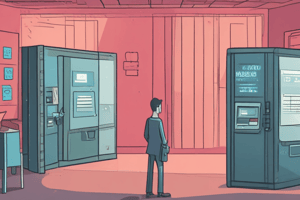Podcast
Questions and Answers
The Password and Access Control Policy is a document that outlines specific responsibilities, conditions, and practices for access control in order to protect physical assets and sensitive information.
The Password and Access Control Policy is a document that outlines specific responsibilities, conditions, and practices for access control in order to protect physical assets and sensitive information.
True (A)
The policy is designed to meet the requirements of the Payment Card Industry Data Security Standard (PCI DSS).
The policy is designed to meet the requirements of the Payment Card Industry Data Security Standard (PCI DSS).
True (A)
The policy applies to all systems and assets owned, managed, or operated by the company.
The policy applies to all systems and assets owned, managed, or operated by the company.
True (A)
The HR role/line manager is responsible for informing IT of new employees, changes to access rights, and leavers.
The HR role/line manager is responsible for informing IT of new employees, changes to access rights, and leavers.
The Information Security Manager reviews and approves access requests and audits user and access lists on a quarterly basis.
The Information Security Manager reviews and approves access requests and audits user and access lists on a quarterly basis.
Systems administrators must adhere to the policy when making changes to access privileges and ensure that all systems enforce the configurations in the policy.
Systems administrators must adhere to the policy when making changes to access privileges and ensure that all systems enforce the configurations in the policy.
User authentication is based on job classification and function, and access privileges are assigned according to business needs.
User authentication is based on job classification and function, and access privileges are assigned according to business needs.
Non-authenticated or shared user IDs are prohibited, and every user must use a unique user ID and password.
Non-authenticated or shared user IDs are prohibited, and every user must use a unique user ID and password.
Secure mechanisms for authentication are required for operating system access, web applications, voice inquiries, email, fax, and remote access.
Secure mechanisms for authentication are required for operating system access, web applications, voice inquiries, email, fax, and remote access.
Network devices must use encrypted protocols for access.
Network devices must use encrypted protocols for access.
Passwords must not be shared, must be at least 8 characters long, and include a combination of upper and lower case letters, numbers, and special characters.
Passwords must not be shared, must be at least 8 characters long, and include a combination of upper and lower case letters, numbers, and special characters.
Password history is maintained, lockout settings are implemented, and two-factor authentication is required for remote access to the cardholder network.
Password history is maintained, lockout settings are implemented, and two-factor authentication is required for remote access to the cardholder network.
Study Notes
Password and Access Control Policy
- The Password and Access Control Policy is a document that outlines specific responsibilities, conditions, and practices for access control in order to protect physical assets and sensitive information.
- The policy is designed to meet the requirements of the Payment Card Industry Data Security Standard (PCI DSS).
- The policy applies to all systems and assets owned, managed, or operated by the company.
- The HR role/line manager is responsible for informing IT of new employees, changes to access rights, and leavers.
- The Information Security Manager reviews and approves access requests and audits user and access lists on a quarterly basis.
- Systems administrators must adhere to the policy when making changes to access privileges and ensure that all systems enforce the configurations in the policy.
- User authentication is based on job classification and function, and access privileges are assigned according to business needs.
- Non-authenticated or shared user IDs are prohibited, and every user must use a unique user ID and password.
- Secure mechanisms for authentication are required for operating system access, web applications, voice inquiries, email, fax, and remote access.
- Network devices must use encrypted protocols for access.
- Passwords must not be shared, must be at least 8 characters long, and include a combination of upper and lower case letters, numbers, and special characters.
- Password history is maintained, lockout settings are implemented, and two-factor authentication is required for remote access to the cardholder network.
Studying That Suits You
Use AI to generate personalized quizzes and flashcards to suit your learning preferences.




